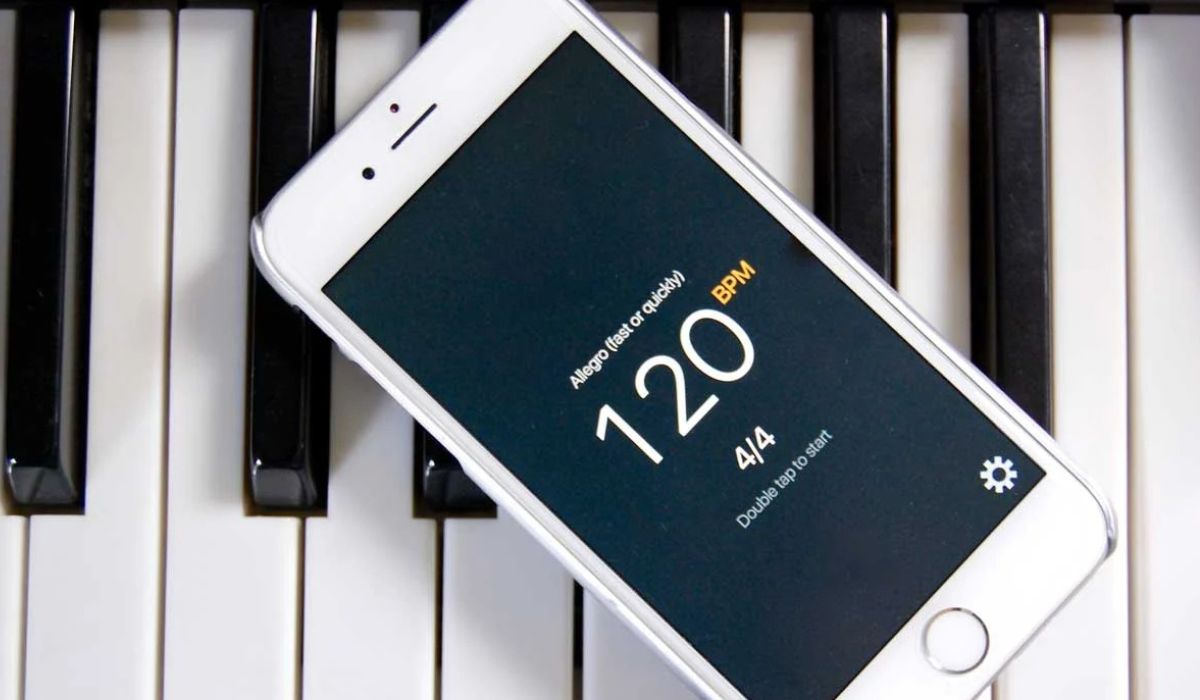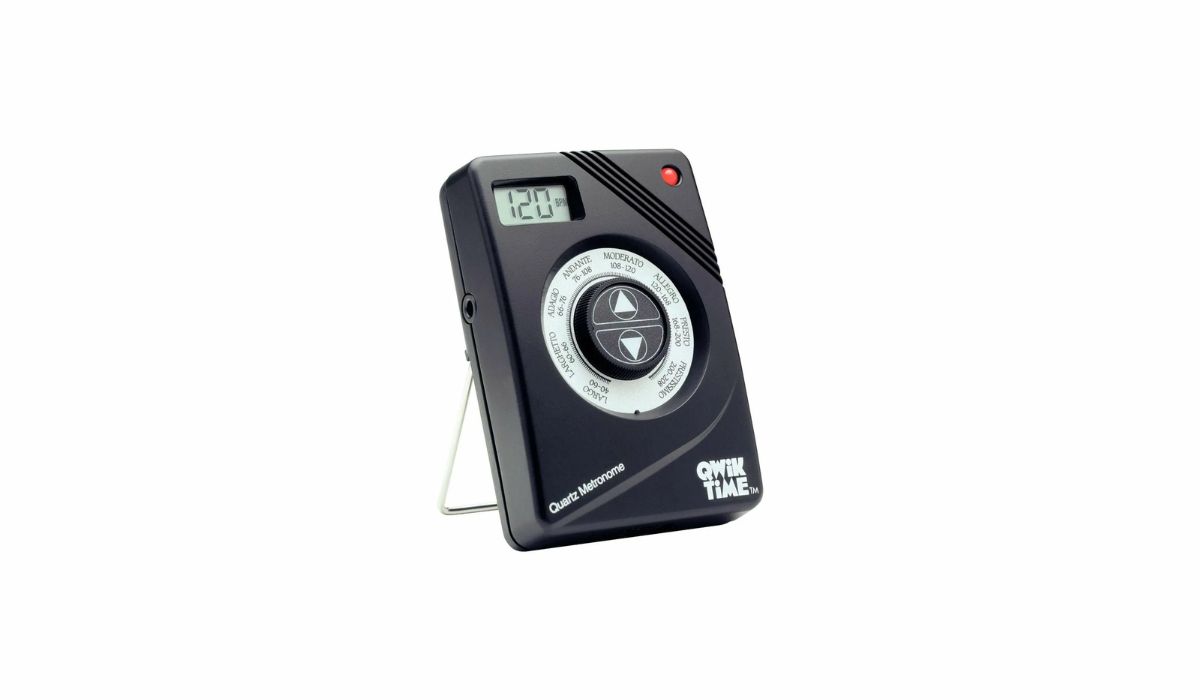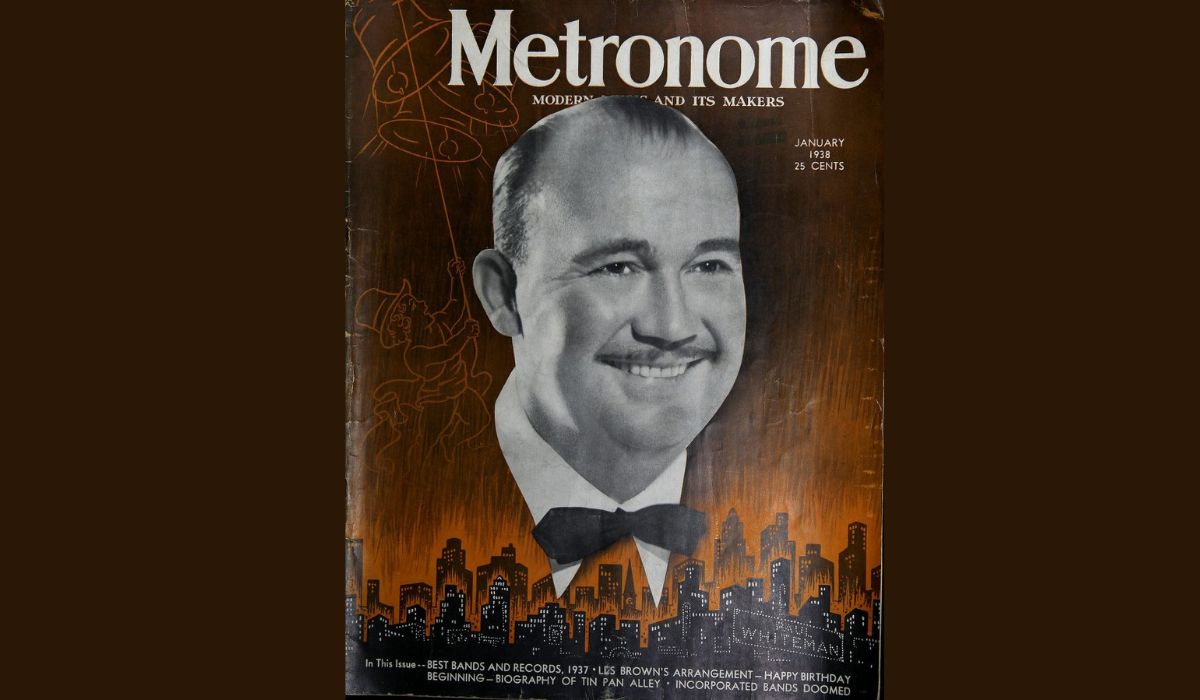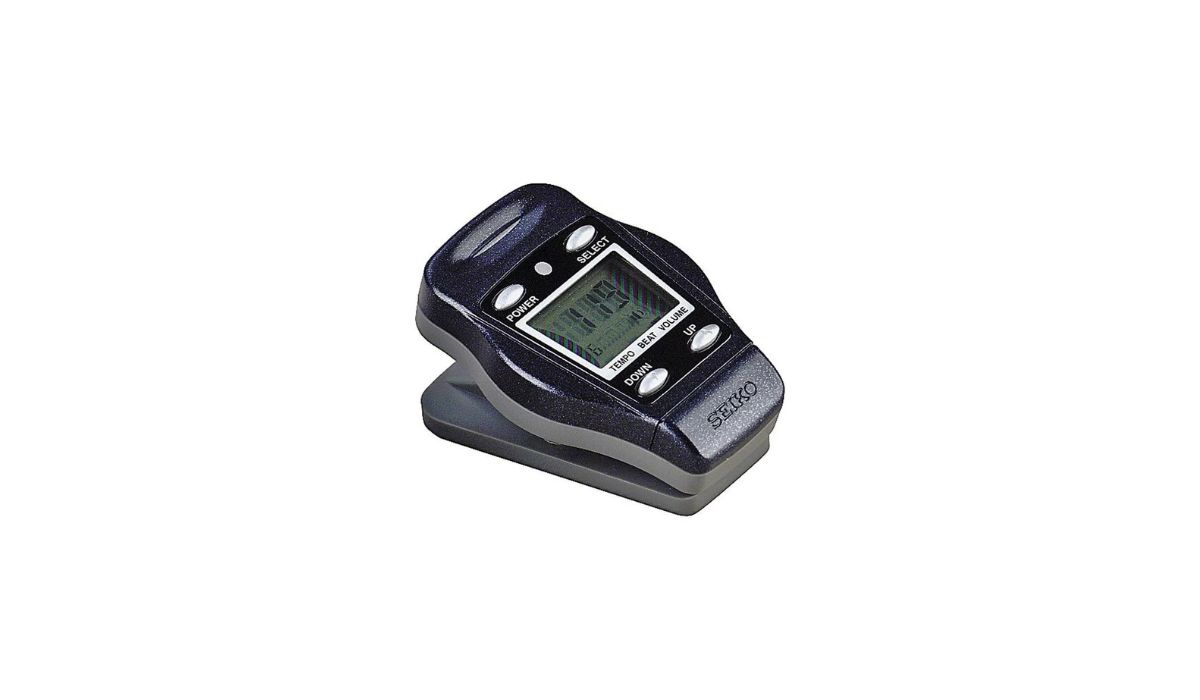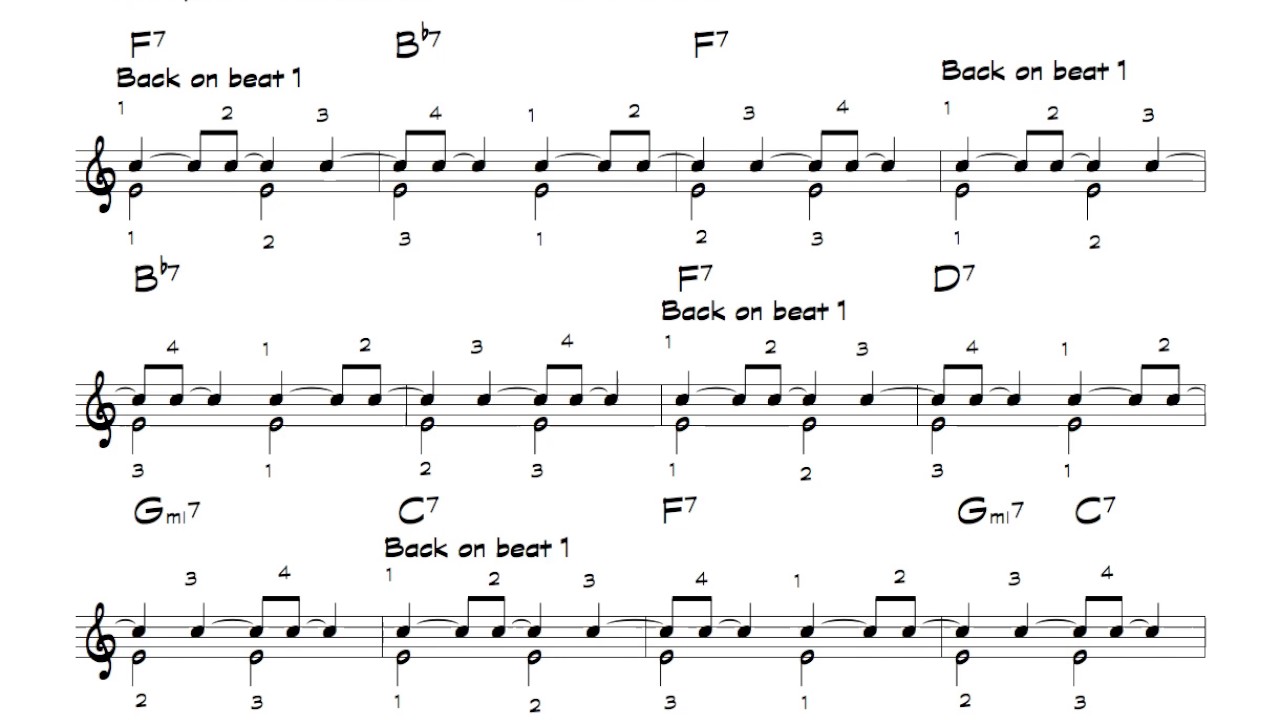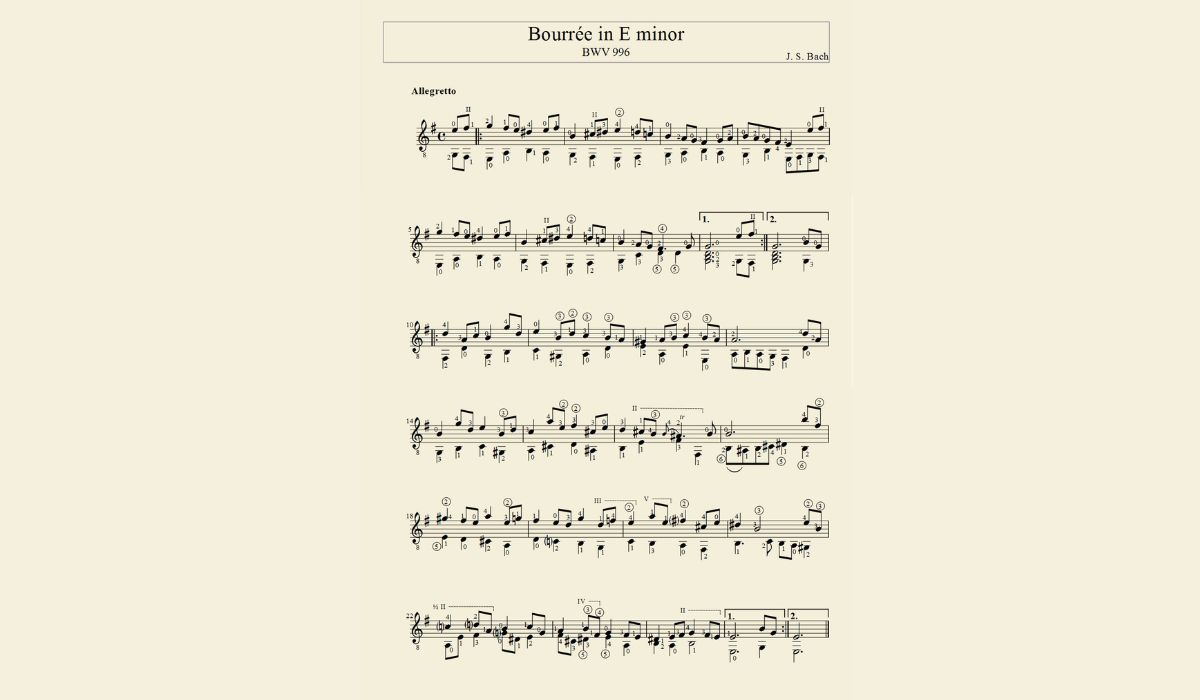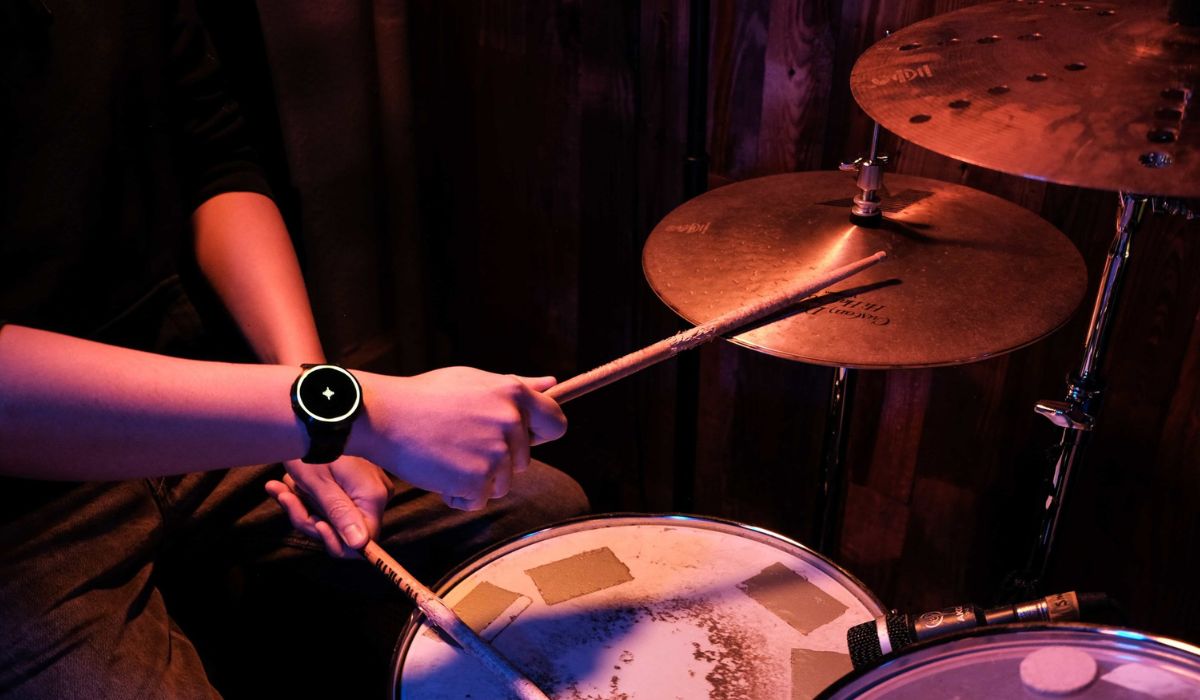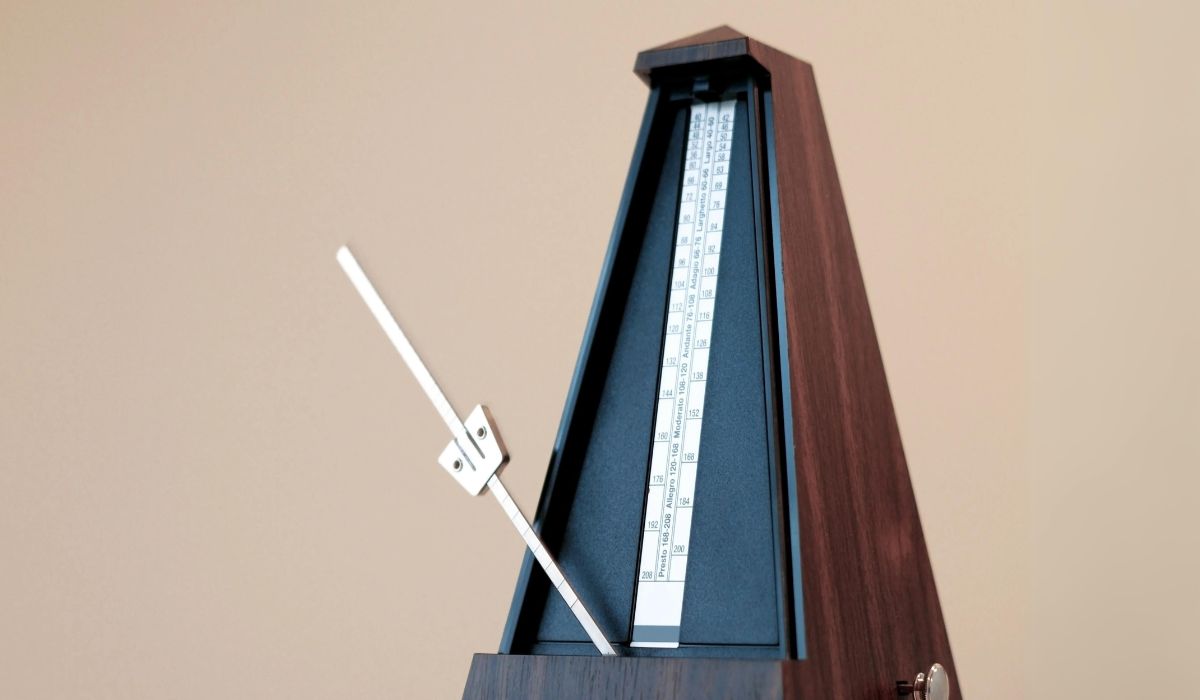Home>Production & Technology>Metronome>What Is A Metronome Marking?
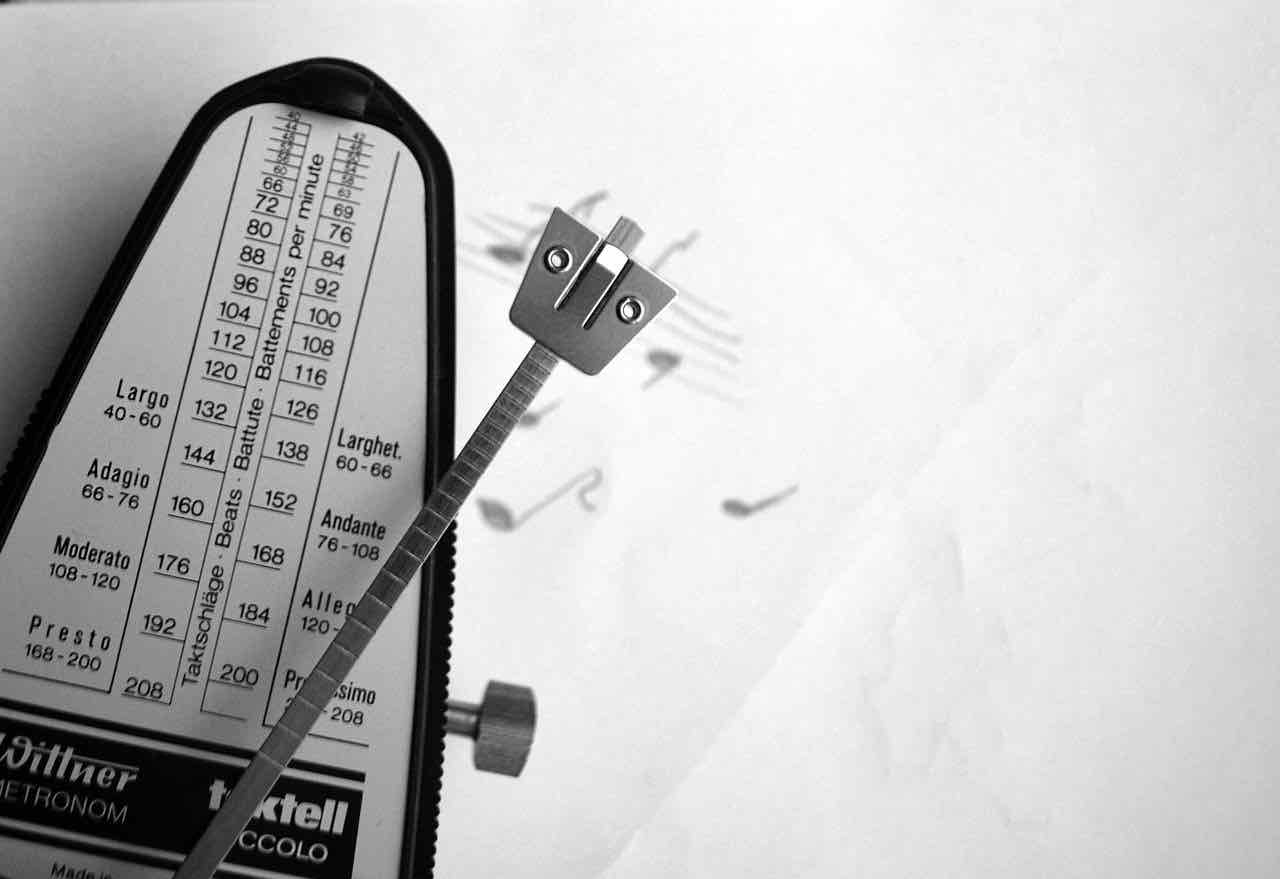

Metronome
What Is A Metronome Marking?
Published: January 14, 2024
Learn everything you need to know about metronome markings - the essential tool for musicians seeking to perfect their timing. Discover how metronomes can enhance your practice sessions.
(Many of the links in this article redirect to a specific reviewed product. Your purchase of these products through affiliate links helps to generate commission for AudioLover.com, at no extra cost. Learn more)
Table of Contents
- Introduction
- Definition of a Metronome Marking
- Importance of Metronome Markings
- Types of Metronome Markings
- How Metronome Markings are Written
- Interpreting Metronome Markings
- Using Metronome Markings in Practice
- Common Metronome Markings in Different Musical Genres
- Famous Examples of Metronome Markings in Classical Music
- Conclusion
Introduction
When it comes to playing music, timing is everything. Whether you’re a seasoned musician or just starting out, maintaining a steady rhythm is essential for a polished performance. That’s where a metronome comes in. A metronome is a device that helps musicians stay on track by producing a steady and consistent beat. But what exactly is a metronome marking?
A metronome marking is a numerical indication of the tempo, or speed, at which a musical piece should be played. It is typically expressed as beats per minute (BPM), representing the number of beats that occur in one minute. For example, a metronome marking of 120 BPM means there should be 120 beats in one minute.
Metronome markings not only provide a reference for tempo, but they also give musicians a precise way to communicate and interpret the intended speed of a composition. They serve as a musical roadmap, ensuring that everyone involved, from performers to conductors, is on the same page and playing at the desired speed.
Understanding and utilizing metronome markings is crucial for musicians of all levels, as it can enhance their performance and overall musicality. By practicing with a metronome and adhering to the prescribed tempo, musicians can develop a strong sense of timing and rhythm, which are fundamental skills in music.
In this article, we will explore the ins and outs of metronome markings, from their importance to their practical application. We will delve into different types of metronome markings, discuss how they are written and interpreted, and provide examples of common metronome markings in various musical genres. Whether you’re a pianist, guitarist, drummer, or any other type of musician, understanding metronome markings can greatly improve your musical skills and performance.
Definition of a Metronome Marking
A metronome marking is a notation used in sheet music to indicate the tempo, or speed, at which a musical piece should be played. It provides musicians with a specific BPM (beats per minute) value, which serves as a reference for maintaining a consistent rhythm throughout the composition.
The metronome marking is usually represented by a number followed by the abbreviation “BPM.” For example, a common metronome marking is “120 BPM,” indicating that there should be 120 beats in one minute. These numbers can range from slow tempos like 40 BPM (adagio) to fast tempos like 200 BPM (presto). The exact choice of metronome marking depends on the musical style, the complexity of the piece, and the desired performance interpretation.
It’s important to note that metronome markings don’t always reflect the emotional or expressive qualities of a piece. While a slower tempo might suggest a more melancholic mood, a faster tempo can evoke excitement or intensity. However, the metronome marking remains a fundamental guideline for maintaining a steady beat, allowing musicians to play together in sync and ensuring a consistent interpretation of the music.
Metronome markings are commonly used in various styles of music, including classical, jazz, rock, and pop. They provide a precise way to convey tempo instructions to performers, allowing them to accurately recreate the intended speed and rhythm of a composition.
While metronome markings are primarily represented by a numerical value, sometimes additional verbal instructions may accompany them. These instructions can provide further guidance on the desired character or style of the performance. For example, a marking of “Moderato (112 BPM)” indicates a moderate speed, while “Largo (40 BPM)” suggests a slow and broad tempo.
Overall, metronome markings serve as a vital tool for musicians, ensuring that they maintain a steady tempo and play the music as intended by the composer. By adhering to the specified metronome marking, musicians can develop a strong sense of timekeeping and seamlessly synchronize with other performers, resulting in a cohesive and compelling musical performance.
Importance of Metronome Markings
Metronome markings play a crucial role in the world of music. They provide musicians with a clear and precise reference for tempo, ensuring that the rhythm of a musical piece is maintained consistently. Here are some key reasons why metronome markings are important:
1. Maintaining a Steady Tempo: One of the primary functions of a metronome marking is to keep musicians in sync and maintain a steady beat throughout a performance. The metronome serves as a reliable timekeeper, helping musicians stay on track and preventing them from rushing or slowing down unintentionally. This is especially important when playing in an ensemble or accompanying other musicians.
2. Accurate Reproduction of the Music: Metronome markings allow musicians to faithfully reproduce the intended speed and rhythm of a composition. By adhering to the specified tempo, performers can ensure that the music is rendered as the composer intended, capturing the essence and character of the piece. Metronome markings provide a common language for musicians to communicate and interpret the tempo requirements of a musical work.
3. Developing a Strong Sense of Timing: By practicing with a metronome and following the indicated metronome marking, musicians can develop a solid sense of timing and rhythm. Regular metronome practice helps musicians internalize the pulse of the music and improves their ability to play accurately and consistently. This applies to musicians of all levels, from beginners building their foundation to professionals honing their skills.
4. Enhancing Ensemble Playing: In ensemble performances, metronome markings are invaluable for ensuring that all members of the group are synchronized and playing together seamlessly. By following the metronome marking, musicians can align their timing, creating a unified and cohesive sound. This becomes crucial when performing complex compositions or intricate musical arrangements.
5. Facilitating Communication and Collaboration: Metronome markings provide a standardized way for musicians to communicate tempo instructions. Whether it’s rehearsing with a band or working with a conductor, metronome markings ensure that everyone involved in the performance is on the same page. They help establish a common understanding and facilitate effective collaboration, allowing for a more cohesive and polished musical interpretation.
Overall, metronome markings are an essential component of musical notation. They provide structure, precision, and consistency, helping musicians stay in time and deliver a faithful performance. By adhering to metronome markings, musicians can elevate their musicality, develop a strong sense of timing, and create a captivating musical experience for both themselves and their audience.
Types of Metronome Markings
Metronome markings come in various forms, each serving a specific purpose in indicating the desired tempo of a musical piece. Here are some common types of metronome markings:
1. Numeric Metronome Markings: Numeric metronome markings are the most common and straightforward type. They consist of a number followed by “BPM” (beats per minute), indicating the specific tempo at which the music should be played. For example, a metronome marking of 120 BPM means there should be 120 beats in one minute. These numeric markings provide a clear and precise reference for tempo and allow musicians to accurately reproduce the intended speed of the composition.
2. Verbal Descriptors: In addition to numeric markings, metronome markings sometimes include verbal descriptors to provide further guidance on the desired character or style of the performance. These descriptors can be in different languages or abbreviations and are often subjective in nature. Common examples include terms like “Largo” (slow and broad), “Moderato” (moderate speed), “Allegro” (fast), or “Presto” (very fast). The use of descriptors alongside numeric markings helps convey the overall mood and expression of the music, facilitating interpretation and performance.
3. Subdivisions and Accents: Some metronome markings incorporate subdivisions and accents to indicate specific rhythmic patterns within a piece. For example, a marking of “8th note = 120” suggests that each beat should be subdivided into eighth notes, with a tempo of 120 beats per minute. Similarly, accents may be marked to indicate emphasized beats or notes within a measure. Subdivisions and accents help musicians maintain precise timing and articulation, particularly in complex rhythmic passages.
4. Tempo Modifiers: Tempo modifiers are used to adjust the overall tempo of a piece relative to the standard metronome marking. These modifiers can be indicated with symbols or abbreviations. For example, an “accel.” marking instructs musicians to gradually increase the tempo, while a “rit.” marking indicates a gradual slowdown. These tempo modifiers provide additional nuances and variations to the performance, allowing musicians to express changes in mood or intensity as directed by the composer.
5. Flexible Metronome Markings: In certain musical styles, flexibility in tempos is desired, allowing for slight variations or rubato. In such cases, metronome markings may include a range rather than a specific BPM value. For example, a marking could indicate a range of 100-110 BPM, giving performers some freedom to fluctuate within that range. Flexible metronome markings allow for a more expressive and organic interpretation of the music.
These are just a few examples of the types of metronome markings that musicians encounter in sheet music. The choice of metronome marking depends on the style of music, the complexity of the composition, and the specific preferences of the composer. Understanding and interpreting these different types of markings is essential for accurately reproducing the tempo and character of a musical piece.
How Metronome Markings are Written
Metronome markings are written in a specific format to ensure clarity and consistency in communicating the desired tempo of a musical piece. Here’s a breakdown of how metronome markings are typically written:
1. Numeric Value: The metronome marking begins with a numeric value that represents the beats per minute (BPM). This number indicates the number of beats that should occur within one minute of playing the piece. It can range from slow tempos like 40 BPM (adagio) to fast tempos like 200 BPM (presto), depending on the specific requirements of the music.
2. BPM Abbreviation: Following the numeric value, the abbreviation “BPM” (beats per minute) is often included to specify the unit of measurement for the tempo. This ensures that musicians understand that the number provided represents the number of beats that should occur within a minute of playing.
3. Placement in the Music: Metronome markings are typically written at the beginning of a musical piece or at the start of a new section in the music. Placing the marking at the beginning allows musicians to quickly reference and establish the desired tempo for the entire composition. At the beginning of each movement or section, a new metronome marking may be provided if there is a change in tempo or character.
4. Verbal Descriptors (Optional): In addition to the numeric value and BPM abbreviation, metronome markings may include verbal descriptors to convey the desired mood, character, or style of the music. These descriptors can be written in various languages or abbreviations and serve to provide further guidance on how the piece should be performed. For example, a metronome marking of “Allegro (120 BPM)” indicates a fast tempo with a lively character.
5. Additional Instructions (Optional): In some cases, metronome markings may include additional instructions or symbols to clarify specific aspects of the tempo or performance. For example, symbols may indicate accents or rhythmic subdivisions, while text may indicate changes in tempo or expressive directions such as “accelerando” (gradually getting faster) or “ritardando” (gradually getting slower). These additional instructions help further refine the interpretation of the music.
It’s important to note that while the standard format for metronome markings is numeric, metronome markings can vary depending on the composer or specific notation style. Different musical genres and periods may have their own conventions for indicating tempo, so it’s essential to be familiar with the specific notation practices of the music you are playing.
By adhering to the established format for metronome markings, musicians can clearly and accurately communicate the intended tempo of a musical piece. This allows for consistent interpretation across different performers and ensures that the music is played as intended by the composer.
Interpreting Metronome Markings
Interpreting metronome markings is crucial for musicians to accurately reproduce the intended tempo and character of a musical composition. Here are some key considerations when interpreting metronome markings:
1. Tempo and Speed: The numeric value of the metronome marking represents the tempo, or speed, at which the music should be played. A higher number indicates a faster tempo, while a lower number suggests a slower tempo. Musicians should internalize the tempo indicated by the metronome marking and strive to maintain a steady and consistent rhythm throughout the piece.
2. Musical Style and Context: The choice of metronome marking is influenced by the musical style and the overall character of the composition. Different genres and periods of music have their own conventions when it comes to tempo. For example, a metronome marking of 60 BPM in a Baroque piece may require a more relaxed and spacious interpretation compared to a mark of 120 BPM in a lively pop song. Understanding the context and style of the music is crucial for interpreting the metronome marking appropriately.
3. Verbal Descriptors and Expressive Indications: Metronome markings sometimes include verbal descriptors that provide additional guidance on the desired mood, character, or style of the performance. Verbal descriptors such as “Allegro” (fast) or “Andante” (walking pace) can provide insight into the intended emotional expression of the music. It’s important to consider these descriptors in conjunction with the numeric value to capture the intended artistic interpretation.
4. Flexibility and Interpretation: While metronome markings provide a specified tempo, there is often room for interpretation within these guidelines. The markings should be used as a reference point rather than a rigid constraint. Musicians have the freedom to add subtle variations, expressive nuances, and subtle rubato within the confines of the overall tempo indicated by the metronome marking. This allows for a more personalized and expressive performance, while still adhering to the fundamental pulse of the music.
5. Listening and Musicality: Interpreting metronome markings involves active listening and a keen sense of musicality. It is essential to listen to recordings and performances of the piece by experienced musicians to gain insights into possible interpretations. By studying different renditions, musicians can develop an understanding of how metronome markings can be applied to bring out the desired nuances and emotion in the music.
6. Collaboration and Ensemble Playing: Communication and collaboration are key when interpreting metronome markings in ensemble playing. It is crucial for all members to have a shared understanding of the metronome marking and to synchronize their timing accordingly. This ensures that the performers are aligned and create a cohesive and unified performance.
Interpreting metronome markings is both an artistic and technical skill. It requires a combination of musical knowledge, sensitivity, and a deep understanding of the composer’s intentions. By carefully studying and interpreting metronome markings, musicians can bring out the true essence of a musical composition and deliver a captivating performance that engages both the performers and the audience.
Using Metronome Markings in Practice
Metronome markings are an invaluable tool in music practice, helping musicians develop a strong sense of timing, rhythm, and precision. Here are some tips for effectively using metronome markings in your practice sessions:
1. Start Slow: When practicing a new piece, begin by setting the metronome to a slower tempo than the indicated marking. This allows you to focus on accuracy and technique without feeling rushed. Gradually increase the tempo as you become more comfortable and confident with the piece.
2. Master Small Sections: Break down the music into smaller sections and practice each section with the metronome. Start by playing at a manageable tempo and gradually work your way up to the desired speed. Remember to focus on maintaining a consistent rhythm and staying in sync with the metronome.
3. Use Subdivisions: For complex rhythms or fast-paced sections, try setting the metronome to a subdivision of the beat. This will help you navigate intricate rhythms and ensure that each note falls accurately within the desired tempo. It improves precision and coordination, especially in passages with syncopation or irregular rhythms.
4. Experiment with Dynamics: While the metronome marking primarily focuses on tempo, don’t forget to incorporate dynamics into your practice. Experiment with different dynamics, such as playing louder or softer, while maintaining the steady beat of the metronome. This will enhance your overall musicality and expression.
5. Gradually Increase Tempo: Once you have achieved accuracy and control at a slower tempo, gradually increase the speed of the metronome to approach the indicated marking. Pay attention to any technical challenges or areas where you may struggle with the faster tempo. Slow down and practice those sections separately, gradually building up speed as you gain proficiency.
6. Practice Different Interpretations: Metronome markings can be interpreted differently based on various musical styles and personal preferences. Use the metronome as a guide, but also explore different interpretations within the given tempo range. Experiment with subtle variations in phrasing, articulation, or rhythmic feel while still maintaining the overall pulse indicated by the metronome.
7. Record and Self-Evaluate: Record yourself practicing with the metronome and listen back to assess your timing, rhythmic accuracy, and overall execution. Take note of any sections that need improvement and work on them specifically. Self-evaluation helps you identify areas where you may need to be more disciplined with the metronome and helps you refine your tempo control skills.
8. Build Confidence: Practicing with a metronome instills a sense of discipline and builds confidence in your ability to play in time. As you become more comfortable with the metronome, you’ll develop a stronger internal sense of timing, enabling you to play with greater stability and precision even in the absence of the metronome.
Remember that using a metronome is not just about playing in strict time; it is about developing a sense of timing, musicality, and precision. Incorporating metronome markings into your practice routine will enhance your overall musicianship, allowing you to perform with confidence, accuracy, and musical expression.
Common Metronome Markings in Different Musical Genres
Metronome markings vary across different musical genres, reflecting the unique rhythmic and stylistic characteristics of each genre. Here are some common metronome markings found in various musical genres:
1. Classical Music: Classical music encompasses a wide range of styles and tempos. In classical compositions, you will often encounter markings such as “Andante” (76-108 BPM, walking pace), “Allegro” (120-168 BPM, fast and lively), “Adagio” (66-76 BPM, slow and expressive), and “Presto” (168-208 BPM, very fast). Classical music is known for its precision and attention to detail, and adhering to the specified metronome markings is essential to capture the intended character of the piece.
2. Jazz: Jazz is a genre that values improvisation and rhythmic flexibility. Metronome markings in jazz can vary depending on the specific style and tempo requirements of the composition. For up-tempo swing tunes, you may encounter metronome markings around 200 BPM or higher. In ballads and slower jazz tunes, metronome markings can range from 60 to 90 BPM. The exact tempo depends on the desired feel and groove of the music, and jazz musicians often add their own interpretations and rhythmic nuances while staying within the general tempo guidelines.
3. Rock and Pop: Rock and pop music encompass a wide variety of styles, ranging from slow ballads to fast-paced anthems. Metronome markings in these genres can vary greatly depending on the specific song or artist. Rock ballads commonly have metronome markings around 60-80 BPM, while more upbeat rock and pop songs can have metronome markings between 100-140 BPM. It’s important to consider the energy and style of the music when interpreting metronome markings in rock and pop genres while staying true to the desired tempo.
4. Latin Music: Latin music is known for its infectious rhythms and vibrant grooves. Metronome markings in Latin music can range from moderate to fast tempos, depending on the specific style, such as salsa, samba, or bossa nova. For example, salsa music often has metronome markings in the range of 180-240 BPM, reflecting the energetic and lively nature of the genre. Latin music allows for rhythmic freedom and syncopation within the given tempo, allowing musicians to add their own flair and rhythmic variations to enhance the overall groove.
5. Electronic and Dance Music: Electronic and dance music are characterized by their driving beats and infectious rhythms. Metronome markings in these genres tend to be faster, generally ranging from 120-180 BPM or higher. The tempo is typically consistent throughout the song to maintain a steady and pulsating groove that keeps the audience dancing. Electronic and dance musicians rely heavily on the metronome to stay synchronized with their sequencers, drum machines, and other electronic instruments to ensure a tight and cohesive performance.
These are just a few examples of common metronome markings in different musical genres. However, it’s important to note that metronome markings can vary widely even within these genres. Each piece of music and each composer may have their own specific tempo instructions, so it’s crucial to read the sheet music carefully and follow the indicated metronome markings to accurately represent the intended style and rhythm of the music.
Famous Examples of Metronome Markings in Classical Music
Metronome markings have played a significant role in classical music, helping to guide performers and convey the intended tempo of a composition. Here are a few famous examples of metronome markings in classical music:
1. Ludwig van Beethoven – Symphony No. 5: Beethoven’s iconic Symphony No. 5 begins with a metronome marking of “Allegro con brio” and 108 BPM. The marking indicates a fast and lively tempo, setting the energetic tone for the entire symphony. This famous metronome marking has become synonymous with the powerful and dramatic opening motif that propels the piece forward.
2. Wolfgang Amadeus Mozart – Symphony No. 40: Mozart’s Symphony No. 40 in G minor is known for its rich melodic themes and emotional depth. The first movement of the symphony features a metronome marking of “Molto allegro” and 140 BPM, showcasing the fast and spirited nature of the composition. This metronome marking guides performers to maintain a brisk and lively tempo throughout the movement.
3. Johann Pachelbel – Canon in D: Pachelbel’s Canon in D is a beloved classical piece known for its timeless beauty. The metronome marking for this piece generally ranges from 60-72 BPM, indicating a slower and stately tempo. This leisurely pace allows the overlapping melodies of the canon to unfold gracefully, creating a serene and enchanting atmosphere.
4. Antonín Dvořák – Symphony No. 9 “From the New World”: Dvořák’s Symphony No. 9 is a masterpiece that seamlessly blends elements of European classical music with American folk influences. The second movement, known as the “Largo,” features a metronome marking of around 60 BPM. This slow tempo, combined with the expressive melodies and rich orchestration, evokes a sense of longing and introspection.
5. Frédéric Chopin – Nocturne in E-flat Major: Chopin’s Nocturne in E-flat Major, Op. 9, No. 2, is a lyrical and introspective solo piano piece. The metronome marking for this composition is typically around 60 BPM, indicating a slow and flowing tempo. This gentle pace allows the pianist to shape the delicate melodies and express the emotional depth of the music.
These examples highlight how metronome markings serve as a guide to the performers, providing them with specific tempo instructions to faithfully interpret the composer’s intentions. While metronome markings provide a foundation for timing and rhythm, it’s important for musicians to infuse their own artistic interpretation within the given tempo, bringing out the unique character and expression of each piece.
Conclusion
Metronome markings are an essential aspect of music notation, providing musicians with precise indications of tempo and rhythm. They serve as a roadmap, guiding performers to maintain a steady beat and accurately reproduce the intended speed and character of a composition. By utilizing metronome markings in practice and performance, musicians can elevate their musicality, improve their sense of timing, and deliver more polished and cohesive performances.
Understanding and interpreting metronome markings is crucial for musicians of all levels and across various genres. Whether it’s classical music, jazz, rock, or Latin music, different genres have their unique conventions and expectations regarding tempo. By following the specified metronome markings, musicians can capture the essence and style of the music, showcasing their technical prowess and expressive abilities.
While metronome markings provide a foundation for timing, it’s important to allow for flexibility and artistic interpretation. Musicians can add their own nuances, dynamics, and rhythmic variations to enhance the overall musicality of a performance. Balancing precision with expressiveness is key, and metronome markings provide a starting point for musicians to navigate within the intended tempo while infusing their own artistic flair.
Practicing with a metronome and incorporating metronome markings into daily practice sessions can greatly improve a musician’s sense of rhythm, timing, and precision. By gradually increasing the tempo, mastering challenging sections, and experimenting with different interpretations, musicians can develop a strong internal pulse and a heightened sense of musicality.
Whether you’re a beginner learning the basics of rhythm or an experienced musician looking to refine your skills, metronome markings offer invaluable guidance and structure. They allow performers to communicate and collaborate effectively, ensuring cohesive ensemble playing and synchronizing with other musicians.
In conclusion, metronome markings are an indispensable tool for musicians. They provide a common language for tempo and rhythm, foster precision in performance, and allow musicians to embody the composer’s intentions. With diligent practice and meticulous attention to metronome markings, musicians can unlock their full potential, deliver captivating performances, and create truly memorable musical experiences.

